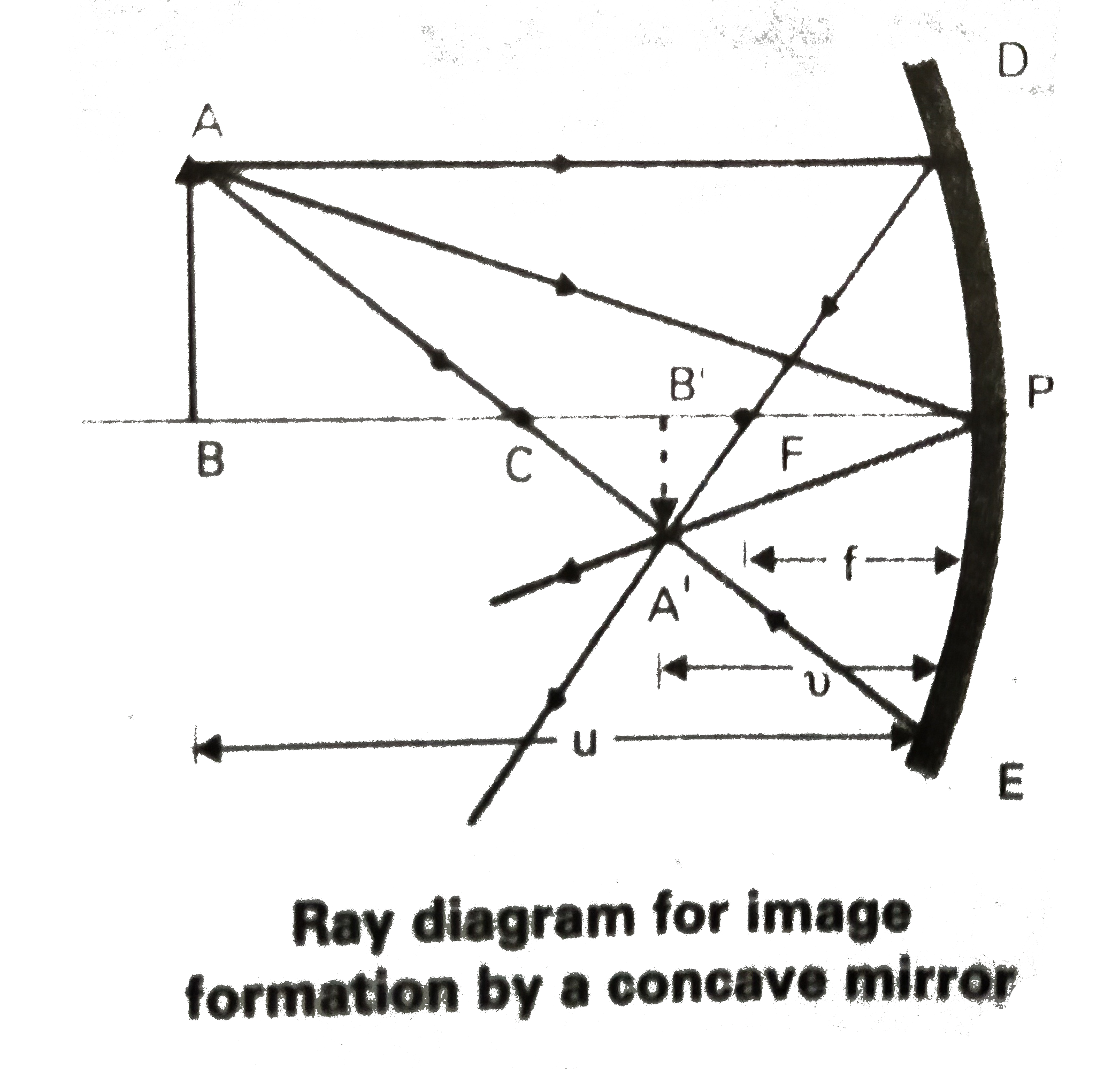Using a neat labelled diagram derive the mirror equation. Define linear magnification.
Text Solution
Derivation of mirror equation : Consider an object AB is placed beyond centre of curvature of a concave mirror, on its principal axis.
A ray AD parallel to principal axis incident on the mirror at point D and is reflected to pass through F.
Another ray AE passing through centre of curvature C is reflected along the same path. Two rays of light intersect at point A'. Thus A'B' is real, inverted and diminished image of AB formed between C and F.
ΔleDPF and Δle A'B'F are similar B'A'PD=B'FFP
(or) B'A'BA=B'FFP ......................... (1) (∴PD=AB)
Since ∠APB=∠A'P'B'
The right angle triangles A'B' P and ABP are similar.
B'A'BA=B'PBP .............................(2)
From equations (1) and (2), B'FFP=B'PBP=B'P−FPFP ............(3)
Now applying the sign convention.
B'P=−υ,FP=−f,BP=−u
−υ+f−f=−υ−u
υ−ff=υu⇒υf−1=υu
1f=1v+1u

Linear magnification :
Linear magnification is the ratio of the size of the image formed by the mirror to the size of the object.
m=size of the imagesize of the object=h2h1=−υu
|
Topper's Solved these Questions
- RAY OPTICAL AND INSTRUMENTSBook:VIKRAM PUBLICATION ( ANDHRA PUBLICATION)Chapter:RAY OPTICAL AND INSTRUMENTSExercise:TEXTUAL EXERCISES
Explore 60 Videos
- RAY OPTICAL AND INSTRUMENTSBook:VIKRAM PUBLICATION ( ANDHRA PUBLICATION)Chapter:RAY OPTICAL AND INSTRUMENTSExercise:SHORT ANSWER QUESTIONS
Explore 10 Videos
- NUCLEIBook:VIKRAM PUBLICATION ( ANDHRA PUBLICATION)Chapter:NUCLEIExercise:DAM SURE (VSAQ)
Explore 1 Video
- SEMICONDUCTOR ELECTRONICS : MATERIALS , DEVICES , AND SIMPLE CIRCUITS Book:VIKRAM PUBLICATION ( ANDHRA PUBLICATION)Chapter:SEMICONDUCTOR ELECTRONICS : MATERIALS , DEVICES , AND SIMPLE CIRCUITS Exercise:ADDITIONAL EXERCISES
Explore 8 Videos
Similar Questions
Draw a neat labelled diagram of nucleus.
View SolutionDraw a neat and labelled diagram of the chloroplast.
View SolutionDraw a neat labelled diagram of a transformer.
View SolutionDraw a neat labelled diagram of a transformer.
View SolutionDraw a neat and labelled diagram of a sarcomere.
View SolutionDraw a neat and labelled diagram of a neuron.
View SolutionDraw a neat and labelled diagram of a tooth.
View SolutionDraw a neat and labelled diagram of a chloroplast.
View SolutionDraw neat and labelled diagram of Nucleosome.
View Solution(a) With the help pf a ray diagram , show how a concave mirror is used to obtain an erect and magnified image of an object .
(b) Using the ray diagram below , obtain the mirror formula and the expression for linear magnification.
View Solution
